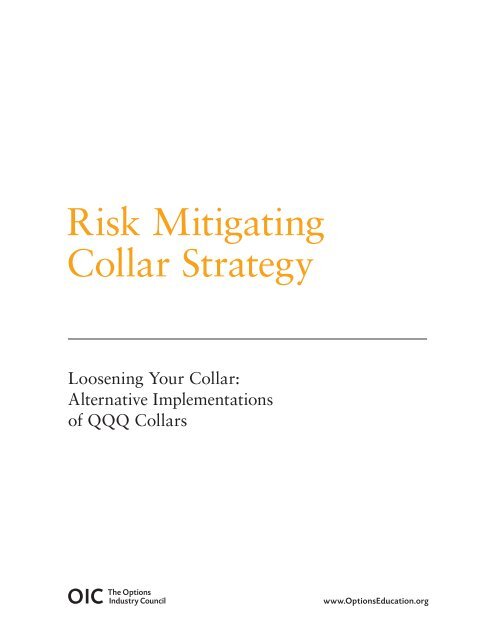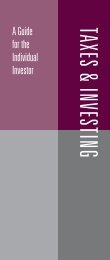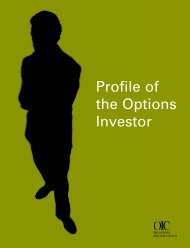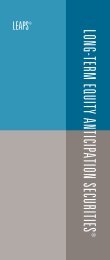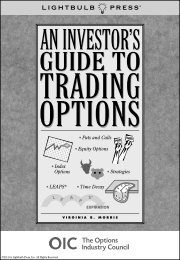Loosening Your Collar - The Options Industry Council
Loosening Your Collar - The Options Industry Council
Loosening Your Collar - The Options Industry Council
Create successful ePaper yourself
Turn your PDF publications into a flip-book with our unique Google optimized e-Paper software.
Risk Mitigating<br />
<strong>Collar</strong> Strategy<br />
<strong>Loosening</strong> <strong>Your</strong> <strong>Collar</strong>:<br />
Alternative Implementations<br />
of QQQ <strong>Collar</strong>s<br />
www.<strong>Options</strong>Education.org
A Summary and Data Update of<br />
<strong>Loosening</strong> <strong>Your</strong> <strong>Collar</strong>:<br />
Alternative Implementations<br />
of QQQ <strong>Collar</strong>s<br />
By Edward Szado and Thomas Schneeweis 1<br />
Fall 2010<br />
About OIC<br />
<strong>The</strong> <strong>Options</strong> <strong>Industry</strong> <strong>Council</strong> (OIC) was<br />
created as an industry cooperative to increase<br />
the awareness, knowledge and responsible use<br />
of exchange-listed options among retail investors,<br />
their financial advisors and institutional investors.<br />
<strong>Options</strong> are a versatile but complex product,<br />
and that is why OIC hosts options seminars,<br />
webcasts and podcasts, distributes software and<br />
literature, and maintains a web site and Help<br />
Desk – all focused on options education.<br />
About PowerShares QQQ TM<br />
PowerShares QQQ, formerly known as<br />
“QQQ” or the “NASDAQ- 100 Index Tracking<br />
Stock ® ”, is an exchange-traded fund based on the<br />
Nasdaq-100 Index ® . <strong>The</strong> Fund will, under most<br />
circumstances, consist of all of stocks in the Index.<br />
<strong>The</strong> Index includes 100 of the largest domestic<br />
and international nonfinancial companies listed<br />
on the Nasdaq Stock Market based on market<br />
capitalization. <strong>The</strong> portfolio is rebalanced quarterly<br />
and reconstituted annually.<br />
<strong>The</strong> <strong>Options</strong> <strong>Industry</strong> <strong>Council</strong> (OIC), as part of its mission to provide education and<br />
research to institutional investors, helped sponsor a paper on the performance of a collar<br />
strategy on the PowerShares QQQ (“QQQQ”) exchange-traded fund (ETF). <strong>The</strong> study<br />
was conducted by Edward Szado and Thomas Schneeweis from the Isenberg School of<br />
Management at the University of Massachusetts. Research support for this study was<br />
provided by OIC. Research results, however, represent those of the authors and do not<br />
necessarily represent the views of OIC. <strong>The</strong> following pages contain a summary of the<br />
study as well as an explanation of the collar strategy.<br />
OIC was formed in 1992. Today, its sponsors<br />
include the U.S. options exchanges and <strong>The</strong><br />
<strong>Options</strong> Clearing Corporation (OCC). OIC’s<br />
Roundtable is the independent governing body<br />
of the <strong>Council</strong> and includes representatives<br />
from the exchanges, member brokerage firms<br />
and OCC. <strong>The</strong>se organizations have one goal<br />
in mind: to provide a financially sound and<br />
efficient marketplace where investors can hedge<br />
investment risk and find new opportunities for<br />
profiting from market participation.<br />
This summary updates the analysis in the original<br />
paper by Szado and Schneeweis (2010) 2 , which<br />
covered the ten year period from March 1999<br />
through May 2009. <strong>The</strong> update now covers the<br />
11½ year performance of the modified collar<br />
strategies ending in September 2010 and highlights<br />
the three year sub-period beginning with<br />
the onset of the financial crisis in September 2007.<br />
<strong>The</strong> authors found that a long protective collar<br />
strategy using six month put purchases and<br />
consecutive one month call writes earned far superior<br />
returns compared to a simple buy-and-hold<br />
strategy while reducing risk by over 60%.<br />
<strong>The</strong> authors also extended the analysis to a more<br />
active implementation of the strategy. While the<br />
passive collar used a constant set of fixed rules,<br />
the active collar used rules that adapt the collar<br />
to changing macroeconomic variables and market<br />
conditions. <strong>The</strong> active collar implementation<br />
generated higher returns than the passive implementation,<br />
while volatility was only slightly higher.<br />
Over the 138-month study period, the passive<br />
collar returned over 185% (9.6% annually), while<br />
the long QQQQ position experienced a “lost<br />
1<br />
Szado, Edward and Thomas Schneeweis, “<strong>Loosening</strong> <strong>Your</strong> <strong>Collar</strong> – Alternative Implementations of QQQ <strong>Collar</strong>s,” Journal of<br />
Trading, Spring 2010, Vol. 5, No. 2, pp. 35-56<br />
January 2011<br />
2<br />
Some minor changes in methodology were made from the Spring 2010 paper. <strong>The</strong> current methodology picks the closest<br />
strike price to the desired strike price from those options with full data over the life of the option. <strong>The</strong> previous study chose the<br />
closest strike to the ATM whereas the current methodology picks the closest strike to the current market whether it is ITM or OTM.<br />
In addition, minor changes in the return streams may have resulted from subsequent data cleaning/updating by OptionMetrics.<br />
1
Exhibit 1.<br />
Results of QQQQ, (Passive and Active <strong>Collar</strong> Strategies),<br />
April 1999 to September 2010*<br />
Growth of $100<br />
(QQQQ, Passive and Active <strong>Collar</strong>) March 1999 to September 2010<br />
Monthly Data: QQQQ TR QQQQ TR<br />
April 1, 1999 to September 30, 2010 QQQQ TR PASSIVE COLLAR ACTIVE COLLAR<br />
$450<br />
QQQQ TR QQQQ 2% OTM Passive <strong>Collar</strong> QQQQ Short Active <strong>Collar</strong><br />
Annualized Return -0.29% 9.56% 12.52%<br />
$400<br />
Annualized Standard Deviation 29.55% 10.66% 11.34%<br />
$350<br />
Sharpe Ratio -0.10 0.64 0.87<br />
$300<br />
Maximum Drawdown -81.08% -17.58% -21.50%<br />
$250<br />
Correlation with QQQQ 1.00 0.38 0.44<br />
Min Monthly Return -26.21% -9.75% -10.21%<br />
Max Monthly Return 23.48% 15.06% 16.38%<br />
Number of Months 138 138 138<br />
% Up Months 54% 64% 67%<br />
% Down Months 46% 36% 33%<br />
* QQQQ TR FUND ONLY - No <strong>Options</strong>; QQQQ TR PASSIVE COLLAR - 2% OTM 1 Mo Call & 2% OTM 6 Mo Put;<br />
QQQQ TR Short ACTIVE COLLAR - 1 Mo Call & 6 Mo Put.<br />
$200<br />
$150<br />
$100<br />
$50<br />
$0<br />
Mar. 99<br />
Mar. 00<br />
Mar. 01<br />
Mar. 02<br />
Mar. 03<br />
Mar. 04<br />
Mar. 05<br />
Mar. 06<br />
Mar. 07<br />
Mar. 08<br />
Mar. 09<br />
Mar. 10<br />
Sep. 10<br />
Figure 1.<br />
decade”, losing 3% over the same period. <strong>The</strong><br />
active collar out-performed both strategies and<br />
returned almost 290% (12.5% annually). Both<br />
collar implementations earned their superior<br />
returns with about one-third of the risk as<br />
measured by the standard deviation (10.7% for<br />
the passive collar; 11.3% for the active collar<br />
versus 29.6% for the QQQQ). During the three<br />
year financial crisis sub-period the passive modified<br />
collar earned a cumulative return of 12%;<br />
the active implementation gained over 16% while<br />
the QQQQ lost over 3%.<br />
<strong>The</strong>re are a variety of options strategies that<br />
can provide capital protection for equity-based<br />
portfolios. <strong>The</strong> most obvious choice is the use<br />
of protective puts. But this choice tends to be<br />
relatively expensive especially in periods of high<br />
volatility. Another options-based approach is the<br />
buy-write or covered call strategy. <strong>The</strong> covered<br />
call strategy typically entails the writing of call<br />
options against a long underlying position at a<br />
one-to-one ratio. Several empirical studies have<br />
suggested that covered call writing can enhance<br />
returns as well as mitigate losses from market<br />
downturns. However, covered call writing still<br />
leaves an investor exposed to large down moves.<br />
<strong>The</strong> collar strategy essentially adds a long protective<br />
put to a covered call strategy. This addition<br />
provides significant downside protection which<br />
the covered call lacks. <strong>The</strong> purchase of the long<br />
put is financed by the sale of the call. In essence,<br />
the collar trades upside participation for downside<br />
protection. A tight collar provides less upside<br />
participation and more downside protection than<br />
a loose collar. At one extreme, the tightest collar<br />
utilizing at-the-money (ATM) puts and calls<br />
effectively immunizes the portfolio from market<br />
movements. At the other extreme, a loose collar<br />
utilizes very far out-of-the-money (OTM) puts<br />
and calls. Between these far OTM strike prices<br />
the collar is essentially equivalent to a long<br />
underlying position.<br />
<strong>The</strong> financial crisis has rekindled interest in<br />
collars and protective strategies in general. In<br />
2008/2009, the QQQQ experienced a drawdown<br />
of roughly 50% from peak to trough. Many<br />
other asset classes that are generally considered<br />
effective equity diversifiers also faced significant<br />
losses. During the market decline, correlations<br />
of most asset classes with broad equity indices<br />
Rolling 12-Month Annualized Standard Deviation<br />
(Active and Passive <strong>Collar</strong>s) February 2000 to September 2010<br />
QQQQ TR QQQQ Short Active <strong>Collar</strong> QQQQ Passive 2% OTM <strong>Collar</strong><br />
0.6<br />
0.5<br />
0.4<br />
0.3<br />
0.2<br />
0.1<br />
0<br />
Feb. 00<br />
Feb. 01<br />
Feb. 02<br />
Feb. 03<br />
Feb. 04<br />
Feb. 05<br />
Feb. 06<br />
Figure 2.<br />
Feb. 07<br />
Feb. 08<br />
Feb. 09<br />
Feb. 10<br />
Sep. 10<br />
2<br />
3
tended to be significantly higher than in previous<br />
years, negating much of the expected benefits<br />
of diversification. This type of contagion across<br />
asset classes suggests that in times of major<br />
systemic stress, direct hedges through protective<br />
options strategies provide equity portfolios<br />
with more benefits than standard diversification<br />
programs.<br />
<strong>The</strong> research assessed the effectiveness of the<br />
passive and active variations of the collar strategy<br />
from March 1999 to September 2010. <strong>The</strong><br />
analysis considered a number of implementations<br />
of long collar strategies with varied moneyness of<br />
the puts and calls as well as times to expiration.<br />
In addition, the collars’ performances were<br />
analyzed with the time period segmented into<br />
three sub-periods. <strong>The</strong>se sub-periods feature<br />
different market environments reflecting conditions<br />
generally favorable and unfavorable to a<br />
collar strategy. <strong>The</strong> protective collars significantly<br />
outperformed the QQQQ in the overall period,<br />
as well as in the two favorable periods (one covers<br />
the technology bubble and one covers the financial<br />
crisis). While the collar variations underperformed<br />
the QQQQ in the unfavorable interim<br />
period, the authors found that in all of the<br />
implementations in all time periods, both collars<br />
significantly reduced risk compared to the buyand-hold<br />
strategy. <strong>The</strong> study further indicated<br />
that the collar variations utilizing six month put<br />
purchases outperformed the one month and<br />
three month put strategies in almost all measures.<br />
<strong>The</strong> slower time decay of the longer maturity<br />
six month puts was a significant benefit to this<br />
collar implementation.<br />
<strong>The</strong> rolling standard deviations in Figure 2<br />
clearly show the risk-reduction benefits of the<br />
collar strategy. <strong>The</strong> collar strategies exhibited<br />
lower standard deviations throughout the entire<br />
period, with the differences ranging from 5 to 45<br />
percentage points. It is also worth noting that the<br />
risk reduction benefits of the active collar strategy<br />
over the passive collar tended to be relatively<br />
subtle, particularly when compared to the difference<br />
between the collars and the QQQQ.<br />
Passive <strong>Collar</strong><br />
This summary focuses on the passive strategy<br />
using the 2% OTM six month put and 2% OTM<br />
one month call. This variation generally exhibited<br />
the best performance and represents a middle<br />
ground between ATM and far OTM. <strong>The</strong> study<br />
explored comparative analyses of maturities and<br />
strike prices. However, these aspects are not<br />
covered in this summary.<br />
<strong>The</strong> effectiveness of the collar strategy in the<br />
April 1999 to September 2002 sub-period is clearly<br />
evident in Exhibit 2. During this period, the<br />
QQQQ was extremely volatile and lost more than<br />
three-quarters of its value from peak to trough.<br />
Specifically, the QQQQ had an annualized loss<br />
of 23.3% with a staggering 42% volatility.<br />
In contrast, the passive collar strategy generated<br />
an annualized positive return of 21.6% at a volatility<br />
of only 13.6%. <strong>The</strong> collar was able to turn<br />
a very sizeable loss into a significant gain while at<br />
the same time reducing risk by more than twothirds.<br />
<strong>The</strong> capital protection ability of the collar<br />
strategy truly shines in this case. <strong>The</strong> collar could<br />
have earned investors a very impressive 21.6% per<br />
year over the sub-period with a maximum loss of<br />
capital of 7.5%, regardless of how poorly investors<br />
timed their entry into the strategy. <strong>The</strong> collar was<br />
an effective way of capturing a significant return<br />
from the bubble run-up without facing the tremendous<br />
losses that came with the collapse.<br />
In the sub-period between October 2002 and<br />
September 2007, steady positive returns, low<br />
volatility and few sharp down moves of the index<br />
explain why the collar strategy was expected to<br />
perform relatively poorly. <strong>The</strong> annualized return<br />
of the QQQQ over this sub-period was an<br />
impressive 20.4% at a relatively moderate<br />
volatility of 17.5%. <strong>The</strong> collar only provided<br />
a 5.2% annualized return over this period.<br />
It did, however, do so at a far lower volatility.<br />
Nevertheless this underperformance was not<br />
nearly as significant as the QQQQ’s underperformance<br />
in the earlier sub-period.<br />
While most asset classes became more correlated<br />
and collapsed during the financial crisis period<br />
from October 2007 to September 2010, the collar<br />
again provided significant capital protection.<br />
<strong>The</strong> annualized loss of 1% in the QQQQ was<br />
converted to a gain of 3.8%, while the standard<br />
deviation was cut from 26.6% to 10.2%. Exhibit<br />
2 and Figure 3 illustrate the protective qualities<br />
of the collar during this period of extreme<br />
market stress.<br />
Active <strong>Collar</strong><br />
<strong>The</strong> active implementation of the collar strategy<br />
used three different sets of signals: momentum 3 ,<br />
volatility 4 and a macroeconomic indicator 5 . Please<br />
refer to the full study for a complete discussion of<br />
the active market signals. Various time horizons<br />
were reviewed in the full study. Since results based<br />
on the shorter-term signals were superior to alternative<br />
combinations, they are summarized below.<br />
Changes in the signals are incorporated into the<br />
strategies only on roll dates. Since puts tend to be<br />
more expensive than calls for a given level of<br />
moneyness, the active strategies begin with puts<br />
further OTM than calls. This allows for the initial<br />
construction of the option component of the<br />
strategy to be close to zero cost. <strong>The</strong> initial<br />
3<br />
<strong>The</strong> momentum signal is a simple moving average cross-over (SMACO) of the NASDAQ-100 Index ® (NDX ® ). A SMACO compares<br />
a short-term moving average (SMA) and a long-term moving average (LMA) to determine whether an upward or downward trend<br />
exists. This summary highlights the shorter 1/50 day moving average cross-over on each roll date (vs. 5/150 day moving average<br />
for medium-term and 1/200 day moving average for long-term) to determine whether to widen the collar (increase the upside participations<br />
with a corresponding reduction in downside protection) or tighten the collar in response to a sell signal (increasing downside<br />
protection while reducing upside participation).<br />
4<br />
<strong>The</strong> volatility signal uses 50-day moving average (MA) of the daily VIX ® close as an indicator of implied volatility levels (versus<br />
150-day MA for medium-term and 250-day moving average for longer-term variations). <strong>The</strong> CBOE Volatility Index ® (VIX) is a<br />
market estimate of expected volatility of the S&P 500 ® Index calculated by using bid/ask quotes of near-term and next-term out-ofthe<br />
money SPX options with at least eight days left to expiration, weighted to yield a constant, 30-day measure of the expected<br />
volatility. <strong>The</strong> strategy writes 0.75 calls to each long index position when the markets short-term anxiety level is high (as indicated by<br />
a situation in which the VIX is above the 50-day, one standard deviation Bollinger band around its current 50-day moving average<br />
level), and writes 1.25 calls per index position when the anxiety level is low (when VIX is below the 50-day, one standard deviation<br />
Bollinger band around the 50-day average level). When the one month implied volatility level is within the one standard deviation,<br />
the strategy follows a standard 1:1 ratio buy-write. <strong>The</strong> goal in varying the quantity of written calls is to have a longer exposure to<br />
the market in times of high anxiety and shorter exposure in times of complacency.<br />
5<br />
<strong>The</strong> macroeconomic signal is based on the trend of initial unemployment claims and the state of the economy with respect to the<br />
business cycle as pronounced by the National Bureau of Economic Research. <strong>The</strong>se announcements are generally considered the<br />
authority on the current state of the business cycle. Since there is often a significant delay in announcement dates, the authors base<br />
the signals on announcement dates to avoid hindsight biases. During expansionary periods stocks rise, counter-intuitively, on bad<br />
unemployment news, while the opposite relationship holds in contractionary periods. One might expect rising unemployment to<br />
negatively affect stock prices regardless of the business cycle, but the authors relied on the existing literature which suggested that<br />
rising unemployment in expansionary economies causes expected future interest rates to decline, increasing the value of equities,<br />
while rising unemployment in contractions indicates slower future earnings growth rates, reducing the value of equities. This summary<br />
highlights the results of the shorter SMACO unemployment signal using 1/10 weeks (vs. 1/30 week for medium-term and 1/40 week<br />
long-term). Since rising unemployment claims in an expansionary economy is a bullish stock market price and volatility signal and if<br />
the SMA is greater than the LMA, the authors shift the collar towards the ATM put and OTM call (increasing both strike prices). In<br />
contractionary economies, rising unemployment claims would cause a shift of the strike prices in the opposite direction.<br />
4 5
$140<br />
$120<br />
$100<br />
$80<br />
$60<br />
$40<br />
$20<br />
$0<br />
QQQQ <strong>Collar</strong><br />
Growth of $100 (QQQQ, Passive and Active <strong>Collar</strong>) October 2007 to September 2010<br />
9/28/07<br />
Figure 3.<br />
QQQQ TR QQQQ 2% OTM Passive <strong>Collar</strong> QQQQ Short Active <strong>Collar</strong><br />
3/28/08<br />
9/28/08<br />
3/28/09<br />
9/28/09<br />
3/28/10<br />
9/28/10<br />
moneyness of the puts and calls is set to 3% OTM<br />
and 2% OTM, respectively. From this initial point,<br />
the momentum signal will widen or tighten the<br />
collar by increasing or decreasing the OTM<br />
amount. <strong>The</strong> macroeconomic signal will shift the<br />
collar up by increasing the OTM amount of the<br />
calls and decreasing the OTM amount of the puts,<br />
or shift the collar down by moving the strike prices<br />
in the opposite direction. <strong>The</strong> volatility signal will<br />
determine whether the ratio of the call write will<br />
be neutral, overwritten or underwritten.<br />
Exhibit 1 provides statistics covering the overall<br />
period. <strong>The</strong> active collar outperformed both the<br />
QQQQ and the passive collar. While the volatility<br />
was slightly higher for the active collar than for<br />
the passive collar, annual returns of the active<br />
exceeded those of the passive by almost three<br />
percentage points. On the other hand, maximum<br />
drawdown and minimum monthly returns were<br />
slightly higher for the active collar.<br />
Results for the three sub-periods are shown in<br />
Exhibit 2. In the first sub-period covering the<br />
technology bubble, the active collar significantly<br />
outperformed the passive collar generating almost<br />
one quarter higher annualized return with very<br />
similar standard deviations. In the second subperiod,<br />
the active collar mitigated the underperformance<br />
of the passive strategy. Annualized returns<br />
improved from 5.2% to 7.7%, while volatility was<br />
slightly reduced. While the improvements of the<br />
active strategy were certainly appealing in the<br />
favorable period, they were even more appealing<br />
in this sub-period in which both collars underperformed<br />
the QQQQ. During the financial crisis subperiod<br />
the active strategy again outperformed the<br />
passive strategy and significantly outperformed the<br />
QQQQ. Annualized returns of the active strategy<br />
versus passive collars were increased from 3.8%<br />
to 5.2% with standard deviations only somewhat<br />
higher. Again the active collar still provided protection<br />
from the annualized 1% QQQQ loss.<br />
Exhibit 2.<br />
QQQQ <strong>Collar</strong> – Sub-Period Results of QQQQ, Passive and Active <strong>Collar</strong> Strategies*<br />
4/1999 to 9/2002 10/2002 to 9/2007 10/2007 to 9/2010<br />
QQQQ TR QQQQ TR QQQQ TR QQQQ TR QQQQ TR QQQQ TR<br />
QQQQ TR 4/1999 PASSIVE to COLLAR 9/2002 ACTIVE COLLAR QQQQ TR 10/2002 PASSIVE to COLLAR 9/2007 ACTIVE COLLAR QQQQ TR PASSIVE 10/2007 COLLAR to 9/2010 ACTIVE COLLAR<br />
Annualized Return -23.31% 21.59% 26.88% 20.37% 5.19% 7.71% -1.03% 3.84% 5.19%<br />
Annualized Standard Deviation 42.44% 13.63% 14.05% 17.54% 7.93% 7.73% 26.56% 10.21% 12.20%<br />
Sharpe Ratio -0.65 1.28 1.62 1.00 0.30 0.63 -0.07 0.30 0.36<br />
Maximum Drawdown -81.08% -7.54% -7.48% -12.36% -14.02% -10.49% -49.74% -17.58% -21.50%<br />
Correlation with QQQQ 1.00 0.26 0.35 1.00 0.67 0.69 1.00 0.63 0.67<br />
Min Monthly Return -26.21% -7.54% -7.48% -12.09% -5.49% -5.57% -15.58% -9.75% -10.21%<br />
Max Monthly Return 23.48% 15.06% 16.38% 18.48% 5.60% 6.19% 13.17% 4.90% 6.28%<br />
Number of Months 42 42 42 60 60 60 36 36 36<br />
% Up Months 40% 74% 74% 62% 57% 63% 58% 67% 64%<br />
% Down Months 60% 26% 26% 38% 43% 37% 42% 33% 36%<br />
* QQQQ TR FUND ONLY - No <strong>Options</strong>; QQQQ TR PASSIVE COLLAR - 2% OTM 1 Mo Call & 2% OTM 6 Mo Put; QQQQ TR Short ACTIVE COLLAR - 1 Mo Call & 6 Mo Put.<br />
6<br />
7
Exhibit 3.<br />
Results of QQQQ (Passive and Active <strong>Collar</strong> Strategies), June 2009 to September 2010<br />
Monthly Data: QQQQ TR QQQQ TR<br />
June 1, 2009 to September 30, 2010 QQQQ TR PASSIVE COLLAR ACTIVE COLLAR<br />
Annualized Return 29.66% 12.43% 16.74%<br />
Annualized Standard Deviation 20.84% 8.44% 10.04%<br />
Sharpe Ratio 1.42 1.46 1.66<br />
Maximum Drawdown -13.09% -5.18% -5.50%<br />
Correlation with QQQQ 1.00 0.60 0.68<br />
Min Monthly Return -7.39% -3.81% -4.05%<br />
Max Monthly Return 13.17% 4.90% 6.28%<br />
Number of Months 17 17 17<br />
% Up Months 71% 65% 71%<br />
% Down Months 29% 35% 29%<br />
* QQQQ TR FUND ONLY - No <strong>Options</strong>; QQQQ TR PASSIVE COLLAR - 2% OTM 1 Mo Call & 2% OTM 6 Mo Put;<br />
QQQQ TR Short ACTIVE COLLAR - 1 Mo Call & 6 Mo Put.<br />
Conclusion<br />
<strong>The</strong> study analyzed the performance of various<br />
passive and active implementations of the collar<br />
strategy on the QQQQ ETF. <strong>The</strong> eleven-year time<br />
horizon since the introduction of the QQQQ<br />
options provided a variety of market conditions in<br />
which to test the performance characteristics of<br />
collar strategies. <strong>The</strong> collar underperformed the<br />
QQQQ in the strong market climb of October<br />
2002 to September 2007. In the period from June<br />
2009 through the end of September 2010 the collar<br />
was expected to perform poorly relative to the<br />
surging recovery for the NASDAQ 100. If one<br />
could accurately pick the market bottom during<br />
the financial crisis, the data shows that a naked<br />
long QQQQ position would have yielded a return<br />
of 29.7% versus an annualized return of 12.4% for<br />
the passive collar. However, the collar carried less<br />
than half the risk (8.4% standard deviation for<br />
the passive collar versus 20.8% for the QQQQ).<br />
<strong>The</strong> return of the active collar implementation was<br />
almost 2/3 of the return of the long QQQQ portfolio,<br />
gaining 16.7% annually but with less than<br />
1/2 the risk (10.0% standard deviation for the<br />
active collar versus 20.8% for the QQQQ).<br />
However, over the entire 138-month period and in<br />
the sub-periods around the technology bubble and<br />
financial crisis, the collar strategies significantly<br />
outperformed a buy-and-hold strategy and<br />
provided much needed capital protection.<br />
<strong>Collar</strong> Strategy<br />
A collar can be established by holding shares of an underlying security, purchasing<br />
a protective put and writing a covered call on that security. <strong>The</strong> underlying security<br />
may be a stock, an exchange-traded fund, a basket of stocks or an index. For the<br />
purpose of this example, the underlying will be referred to as stock. Generally, the<br />
put and the call are both out-of-the-money when this combination is established, and<br />
have the same expiration month. But collars can also be implemented with puts and<br />
calls of varied intrinsic value and time to maturity. Both the buy and the sell sides<br />
of this combination are opening transactions, and are normally the same number of<br />
contracts. In other words, one collar equals one long put and one written call along<br />
with owning 100 shares of the underlying stock. <strong>The</strong> primary concern in employing<br />
a collar is protection of profits accrued from underlying shares rather than increasing<br />
returns on the upside.<br />
<strong>Collar</strong><br />
+<br />
Profit<br />
Loss<br />
–<br />
Put<br />
Strike<br />
Price<br />
Call<br />
Strike<br />
Price<br />
Higher Strike<br />
Price<br />
Stock Price<br />
Market Opinion<br />
Neutral, following a period of appreciation.<br />
When to Use<br />
An investor will employ this strategy after accruing<br />
unrealized profits from the underlying shares,<br />
and wants to protect these gains with the purchase<br />
of a protective put. At the same time, the investor<br />
is willing to sell his stock at a price higher than<br />
the current market price so an out-of-the money<br />
call contract is written, covered in this case by the<br />
underlying stock.<br />
Graph assumes accrued stock profit when establishing combination<br />
8<br />
9
Benefit<br />
Risk vs. Reward<br />
Break-Even Point (BEP) at Expiration<br />
Alternatives Before Expiration<br />
This strategy offers the stock protection of a<br />
put. However, in return for accepting a limited<br />
upside profit potential on his underlying shares<br />
(to the call’s strike price), the investor writes a<br />
call contract. Because the premium received from<br />
writing the call can offset the cost of the put, the<br />
investor is obtaining downside put protection at a<br />
smaller net cost than the cost of the put alone. In<br />
some cases, depending on the strike prices and the<br />
expiration month chosen, the premium received<br />
from writing the call will be more than the cost<br />
of the put. In other words, the combination can<br />
sometimes be established for a net credit; the<br />
investor receives cash for establishing the position.<br />
<strong>The</strong> investor keeps the cash credit, regardless of<br />
the price of the underlying stock when the options<br />
expire. Until the investor either exercises his put<br />
and sells the underlying stock, or is assigned an<br />
exercise notice on the written call and is obligated<br />
to sell his stock, all rights of stock ownership<br />
are retained.<br />
Net Upside Stock Sale Price if<br />
Assigned on the Written Call<br />
This example assumes an accrued profit from<br />
the investor’s underlying shares at the time the<br />
call and put positions are established, and that<br />
this unrealized profit is being protected on the<br />
downside by the long put. <strong>The</strong>refore, discussion<br />
of maximum loss does not apply. Rather, in<br />
evaluating profit and/or loss below, bear in mind<br />
the underlying stock’s purchase price (or cost<br />
basis). Compare that to the net price received at<br />
expiration on the downside from exercising the put<br />
and selling the underlying shares, or the net sale<br />
price of the stock on the upside if assigned on the<br />
written call option. This example also assumes<br />
that when the combined position is established,<br />
both the written call and purchased put are<br />
out-of-the-money.<br />
If the underlying stock price is between the strike<br />
prices of the call and put when the options expire,<br />
both options will generally expire with no value.<br />
In this case, the investor will lose the entire net<br />
premium paid, or keep the entire net cash credit<br />
received when establishing the combination.<br />
Balance either result with the underlying stock<br />
profits accrued when the combination was<br />
established.<br />
Net Downside Stock Sale Price if<br />
Exercising the Long Put<br />
In this example, the investor is protecting his<br />
accrued profits from the underlying stock with<br />
a sale price for the shares guaranteed at the long<br />
put’s strike price. In this case, consideration of<br />
break-even point does not apply.<br />
Time Decay<br />
Passage of Time: Positive Effect<br />
<strong>The</strong> effect of time decay on this strategy varies with<br />
the underlying stock’s price level in relation to the<br />
strike prices of the long and short options. If the<br />
stock price is midway between the strike prices, the<br />
effect can be minimal. If the stock price is closer<br />
to the lower strike price of the long put, losses<br />
generally increase at a faster rate as time passes.<br />
Alternatively, if the underlying stock price<br />
is closer to the higher strike price of the written<br />
call, profits generally increase at a faster rate as<br />
time passes.<br />
<strong>The</strong> combination may be closed out as a unit<br />
just as it was established as a unit. To do this, the<br />
investor enters a combination order to buy a call<br />
with the same contract terms and sell a put with<br />
the same contract terms, paying a net debit or<br />
receiving a net cash credit as determined by current<br />
option prices in the marketplace.<br />
Alternatives at Expiration<br />
If the underlying stock price is between the put<br />
and call strike prices when the options expire,<br />
the options will generally expire with no value.<br />
<strong>The</strong> investor will retain ownership of the<br />
underlying shares and can either sell them or<br />
hedge them again with new option contracts. If the<br />
stock price is below the put’s strike price as the<br />
options expire, the put will be in-the-money and<br />
have value. <strong>The</strong> investor can elect to either sell the<br />
put before the close of the market on the option’s<br />
last trading day and receive cash, or exercise the<br />
put and sell the underlying shares at the put’s strike<br />
price. Alternatively, if the stock price is above the<br />
call’s strike price as the options expire, the short<br />
call will be in-the-money and the investor can<br />
expect assignment to sell the underlying shares at<br />
the strike price. Or, if retaining ownership of the<br />
shares is now desired, the investor can close out<br />
the short call position by purchasing a call with the<br />
same contract terms before the close of trading.<br />
Call’s Strike Price plus Net Credit Received<br />
for Combination<br />
or<br />
Call’s Strike Price minus Net Debit Paid<br />
for Combination<br />
Put’s Strike Price plus Net Credit<br />
Received for Combination<br />
or<br />
Put’s Strike Price minus Net Debit Paid<br />
for Combination<br />
Risk vs. Reward.<br />
10<br />
11
For more information on OIC or the collar strategy, or for a copy<br />
of the full study, contact <strong>The</strong> <strong>Options</strong> <strong>Industry</strong> <strong>Council</strong> at 1-888-OPTIONS<br />
or visit www.<strong>Options</strong>Education.org/institutional.<br />
References<br />
Arditti, F. D., “Risk and the<br />
Required Return on Equity.”,<br />
Journal of Finance, 1967, Vol.<br />
22, No. 1: 19-36.<br />
Bakshi, G., and N. Kapadia.,<br />
“Delta-Hedged Gains and the<br />
Negative Market Volatility Risk<br />
Premium”, Review of Financial<br />
Studies, 2003, Vol. 16,<br />
No. 2: 527-566.<br />
Callan Associates Inc.,<br />
“Profit/Loss An Historical<br />
Evaluation of the CBOE S&P<br />
500 Buy-Write Index Strategy”,<br />
Callan Associates Inc.<br />
October 2006.<br />
Feldman, Barry, and Dhruv<br />
Roy., “Passive <strong>Options</strong>-Based<br />
Investment Strategies: <strong>The</strong><br />
Case of the CBOE S&P 500<br />
Buy-Write Index”, Ibbotson<br />
Associates July 28, 2004.<br />
Hill, Joanne M., Venkatesh<br />
Balasubramanian, Krag<br />
(Buzz) Gregory, and Ingrid<br />
Tierens., “Finding Alpha via<br />
Covered Call Writing”,<br />
Financial Analysts Journal,<br />
Sept/Oct 2006, 27-46.<br />
Jegadeesh, Narasimhan, and<br />
Sheridan Titman “Momentum.”<br />
University Of Illinois,<br />
Working Paper, October 23,<br />
2001.<br />
Kapadia, Nikunj and Edward<br />
Szado., “<strong>The</strong> Risk Return<br />
Characteristics of the<br />
Buy-Write Strategy on the<br />
Russell 2000 Index”, Journal<br />
of Alternative Investments,<br />
Spring 2007, 39-56.<br />
Leland, Hayne E., “Beyond<br />
Mean-Variance: Performance<br />
Measurement in a Non-<br />
Symmetrical World”,<br />
Financial Analysts Journal<br />
Jan/Feb 1999, 27-35.<br />
Renicker, Ryan and Devapriya<br />
Mallick., “Enhanced Call<br />
Overwriting”, Lehman Brothers<br />
Global Equity Research,<br />
Nov. 17, 2005.<br />
Schneeweis, Thomas and<br />
Richard B Spurgin., “<strong>The</strong><br />
Benefits of Index Option-Based<br />
Strategies for Institutional<br />
Portfolios.” Journal of<br />
Alternative Investments,<br />
Spring 2001, 44-53.<br />
Spurgin, R., “How to Game<br />
<strong>Your</strong> Sharpe Ratio”, Journal of<br />
Alternative Investments,<br />
Winter 2001, 38-46.<br />
Stutzer, Michael, “A Portfolio<br />
Performance Index”, Financial<br />
Analysts Journal, May/June<br />
2000, Vol. 56, No. 3: 52-61.<br />
Szado, Edward and Hossein<br />
Kazemi., “<strong>Collar</strong>ing the Cube:<br />
Protection <strong>Options</strong> for a QQQ<br />
ETF Portfolio”, Journal of<br />
Alternative Investments, Spring<br />
2009, 24-42.<br />
Ungar, J., and M.T. Moran.,<br />
“<strong>The</strong> Cash-secured Put-Write<br />
Strategy and Performance<br />
of Related Benchmark<br />
Indexes”, Journal of Alternative<br />
Investments, Spring 2009,<br />
43-56.<br />
Whaley, Robert E., “Return<br />
and Risk of CBOE Buy-Write<br />
Monthly Index”, <strong>The</strong> Journal<br />
of Derivatives, Winter 2002,<br />
35-42.<br />
<strong>The</strong> information in this brochure is not intended and should not be construed to constitute investment advice or recommendations<br />
to purchase or sell securities. OIC makes no representation as to the appropriateness of this strategy for any investor. <strong>Options</strong><br />
involve risk and are not suitable for all investors. Prior to buying or selling an option, a person must receive a copy of Characteristics<br />
and Risks of Standardized <strong>Options</strong> (ODD). Copies of the ODD may be obtained from your broker, from any exchange on which<br />
options are traded or by contacting <strong>The</strong> <strong>Options</strong> Clearing Corporation, One North Wacker Drive, Suite 500, Chicago, IL 60606<br />
(1-888-678-4667). Both the passive and active collar strategies do not take into account significant factors such as transaction<br />
costs and taxes and it should be understood that past performance does not guarantee future results.<br />
PowerShares QQQ is a registered trademark of Invesco Powershares Capital Management LLC.<br />
Nasdaq-100, Nasdaq 100 Index and NDX are registered trademarks of <strong>The</strong> Nasdaq Stock Market, Inc.<br />
S&P 500 is a registered trademark of the McGraw-Hill Companies, Inc.<br />
CBOE Volatility Index and VIX are registered trademarks and SPX is a servicemark of Chicago Board <strong>Options</strong> Exchange, Inc.<br />
©<strong>The</strong> <strong>Options</strong> <strong>Industry</strong> <strong>Council</strong><br />
12
One North Wacker Drive, Suite 500<br />
Chicago, Illinois 60606<br />
1-888-OPTIONS<br />
www.<strong>Options</strong>Education.org


